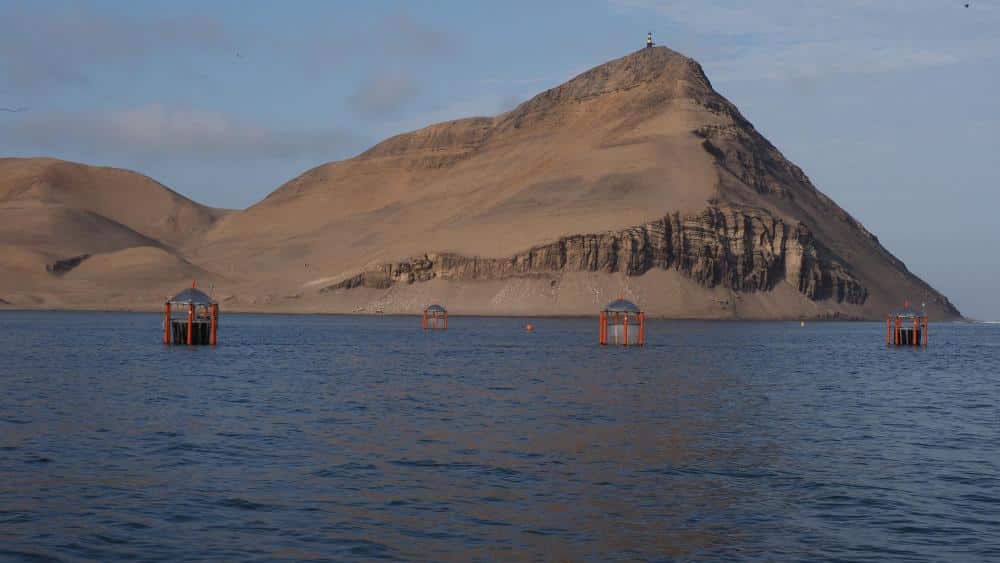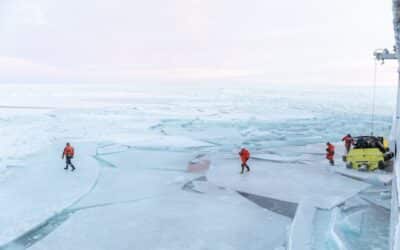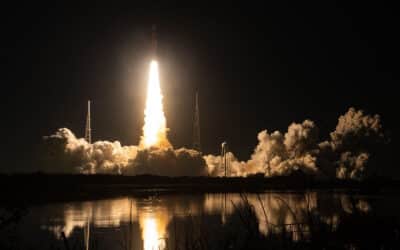by Anja Chalmin
Marine geoengineering: further offshore trials announced
The coastal waters off Callao, in the Humboldt Current of the coast of Peru, were the scene of upwelling trials from February to April, performed by the GEOMAR Helmholtz Centre for Ocean Research Kiel and further German research institutions. The offshore trials were conducted as part of the CUSCO project, in so-called mesocosms (large tubes), testing the effects of varying upwelling intensities, for example on plankton communities and biomass production.
Since the beginning of July, GEOMAR is also coordinating the European-funded project Ocean-based Negative Emission Technologies. OceanNETs is conducted in cooperation with thirteen research institutions from Europe and abroad, and aims to investigate the feasibility and impacts of ocean-based approaches for the removal of CO2 from the atmosphere. A detailed research programme is not yet publicly available, but a graphical representation on the project website refers almost exclusively to ocean-based geoengineering approaches, among them the production of marine biomass for Biochar and BECCS, artificial upwelling or downwelling, ocean fertilisation, and marine enhanced weathering. A summary description of the research project reveals plans to conduct offshore experiments in mesocosms off Gran Canaria, Spain and Bergen, Norway. These trials aim to dissolve alkaline minerals in seawater, to test the effects of marine enhanced weathering.
Marine Geoengineering Approaches Used in the Projects Described
Artificial Upwelling (CUSCO trials) aims to artificially transport nutrient-rich deep ocean water to upper ocean layers, in order to stimulate the growth of phytoplankton. In theory, the new phytoplankton will absorb CO2 and store carbon as soon as dead phytoplankton biomass sinks to the ocean floor. In practice, AU is unproven and could pose threats to ecological cycles, fisheries and the climate.
Enhanced Weathering (OceanNets & Project Vesta trials) aims to mimic and accelerate very slow-moving natural weathering and carbonation processes. The approach involves mining, crushing and transporting large quantities of selected rocks, for example olivine-rich basalt, and dumping them onto beaches or directly into the ocean. The proposal is associated with great energy consumption and environmental damages due to increased mining activities. The potential effects on marine biochemical processes or the marine food chain are unknown.
Marine Cloud Brightening (Great Barrier Reef trials) suggests shooting large amounts of seawater droplets into marine clouds, in order to create whiter clouds and to reflect more sunlight back to space. The altered solar radiation may have impacts on weather patterns with potentially calamitous ecological impacts on larger regions.
After conducting a four-day trial to test Marine Cloud Brightening (MCB) technology in the Australian Great Barrier Reef area in March, larger-scale trials were announced in the years ahead, covering between 120 km² to 400 km². The goal of the trials is to test MCB as a mean to protect the Great Barrier Reef from coral bleaching, by creating larger and more reflective clouds above the reef area, in order to cool the water underneath. To create whiter clouds, sea water is pumped through a filer and sprayed out of small nozzles from a vessel. The nozzles produce minuscule water droplets, which are propelled into the atmosphere by a large fan. According to the hypothesis, the water evaporates, leaving behind tiny particles of salt to which other water droplets can then condense in order to form brighter and more reflective clouds. The concept has been proposed and developed by several Australian research institutions, and funding is provided via the governmental Reef Restoration and Adaptation Program (RRAP). A coalition of nearly 200 environmental groups protested against the experiment, because it violates a 2010 United Nations moratorium on ocean geoengineering. The ecological and social impacts of large-scale solar geoengineering, and Marine Cloud Brightening in particular, are unknown.
The Australian RRAP, funded by the Australian Federal Government, Australian universities and research institutes, has as its official aim to help the Great Barrier Reef resist, adapt to, and recover from the impacts of climate change and consists of a partnership of Australian scientists, engineers, modellers and economist. The RRAP Investment Case and Concept Feasibility Study, conducted from 2018 to 2019, looked at 160 proposed interventions, of which 43 were selected for further research and trials. In addition to the announced large-scale MCB trials, the next program phase will explore additional marine geoengineering approaches, among them brightening the surface water with microbubbles, shading the water above the reef area by producing mist and fog, or by applying a floating sunscreen on the water surface.
The California-based organisation Ice911 is pursuing a marine geoengineering approach that would cover Arctic ice with a layer of floating reflective material, aiming to slow down the melting and prevent ice from breaking off and floating south, where it melts. Since 2010, Ice911 has conducted trials on various lakes in Northern America, their largest test site is the Arctic North Meadow Lake near Utqiagvik, in Alaska. This year’s trial on the lake started in June, in cooperation with Ukpeaġvik Iñupiat Corporation (UIC), Ice911’s new local partner. Ice911 describes UIC as a “community partner”. The UIC website explains that UIC is one the largest companies in Alaska, e.g. offering military and logistics support services in an Arctic environment as well as supporting oil & gas development. An interview, conducted by ETC Group’s Dru Jay, reveals that the trials on the North Meadow Lake are undertaken without the informed consent of local communities, in addition they are considered as another risk factor for communities in the Arctic. Since 2018, Ice911 has been looking for funding and governmental permissions to conduct large-scale testing on arctic ice, proposing to cover 15.000 km² to 100.000 km² with reflective silica-based material. A large-scale intervention in Fram Strait is currently being modelled by Ice911, although the current knowledge of the reflective material’s behaviour in the marine environment, for example on plant and animal life, is insufficient, and the impacts in the target regions or on regional cycles or global weather patterns are difficult to determine.
Another outdoor experiment, aiming to trial enhanced weathering on a tropical beach in the Caribbean, has been announced by Project Vesta. The project, founded by Eric Matzner in 2019, plans to mine and grind large quantities of olivine rock and spread it onto beaches, where wave action would support the weathering process. In May, Stripe announced to fund Project Vesta with US$ 0,25 million. According to a report in MIT the project “has secured local permission to begin conducting sampling at the beaches and intends to announce the location once it’s finalized approvals to move ahead with the experiment”.
Sources:
ETC Group and Heinrich Böll Foundation (2020) Geoengineering Map, https://map.geoengineeringmonitor.org/
Heinrich Böll Foundation and ETC Group (2020) Geoengineering – Technical Briefings, July 2020, LINK



